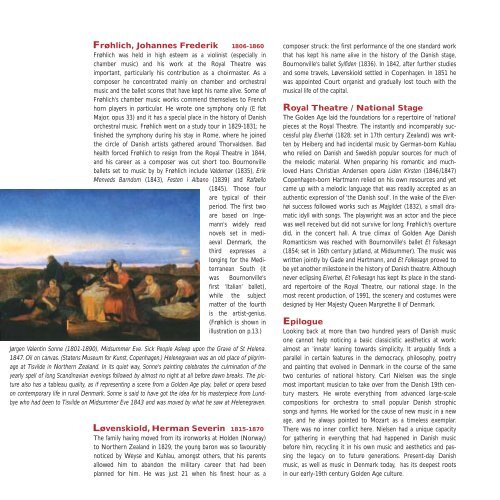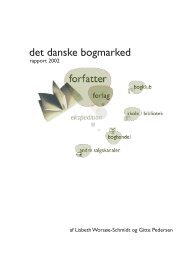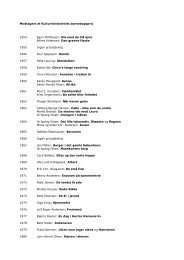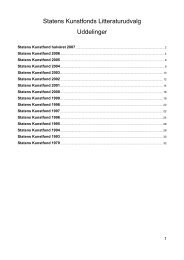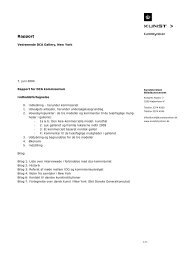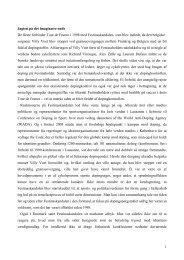Danish Music: The Golden Age 1800-1850
Danish Music: The Golden Age 1800-1850
Danish Music: The Golden Age 1800-1850
Create successful ePaper yourself
Turn your PDF publications into a flip-book with our unique Google optimized e-Paper software.
Frøhlich, Johannes Frederik 1806-1860<br />
Frøhlich was held in high esteem as a violinist (especially in<br />
chamber music) and his work at the Royal <strong>The</strong>atre was<br />
important, particularly his contribution as a choirmaster. As a<br />
composer he concentrated mainly on chamber and orchestral<br />
music and the ballet scores that have kept his name alive. Some of<br />
Frøhlich's chamber music works commend themselves to French<br />
horn players in particular. He wrote one symphony only (E flat<br />
Major, opus 33) and it has a special place in the history of <strong>Danish</strong><br />
orchestral music. Frøhlich went on a study tour in 1829-1831; he<br />
finished the symphony during his stay in Rome, where he joined<br />
the circle of <strong>Danish</strong> artists gathered around Thorvaldsen. Bad<br />
health forced Frøhlich to resign from the Royal <strong>The</strong>atre in 1844,<br />
and his career as a composer was cut short too. Bournonville<br />
ballets set to music by by Frøhlich include Valdemar (1835), Erik<br />
Menveds Barndom (1843), Festen i Albano (1839) and Rafaello<br />
(1845). Those four<br />
are typical of their<br />
period. <strong>The</strong> first two<br />
are based on Ingemann's<br />
widely read<br />
novels set in mediaeval<br />
Denmark, the<br />
third expresses a<br />
longing for the Mediterranean<br />
South (it<br />
was Bournonville's<br />
first 'Italian' ballet),<br />
while the subject<br />
matter of the fourth<br />
is the artist-genius.<br />
(Frøhlich is shown in<br />
illustration on p.13.)<br />
Jørgen Valentin Sonne (1801-1890), Midsummer Eve. Sick People Asleep upon the Grave of St Helena.<br />
1847. Oil on canvas. (Statens Museum for Kunst, Copenhagen.) Helenegraven was an old place of pilgrimage<br />
at Tisvilde in Northern Zealand. In its quiet way, Sonne's painting celebrates the culmination of the<br />
yearly spell of long Scandinavian evenings followed by almost no night at all before dawn breaks. <strong>The</strong> picture<br />
also has a tableau quality, as if representing a scene from a <strong>Golden</strong> <strong>Age</strong> play, ballet or opera based<br />
on contemporary life in rural Denmark. Sonne is said to have got the idea for his masterpiece from Lundbye<br />
who had been to Tisvilde on Midsummer Eve 1843 and was moved by what he saw at Helenegraven.<br />
Løvenskiold, Herman Severin 1815-1870<br />
<strong>The</strong> family having moved from its ironworks at Holden (Norway)<br />
to Northern Zealand in 1829, the young baron was so favourably<br />
noticed by Weyse and Kuhlau, amongst others, that his parents<br />
allowed him to abandon the military career that had been<br />
planned for him. He was just 21 when his finest hour as a<br />
composer struck: the first performance of the one standard work<br />
that has kept his name alive in the history of the <strong>Danish</strong> stage,<br />
Bournonville's ballet Sylfiden (1836). In 1842, after further studies<br />
and some travels, Løvenskiold settled in Copenhagen. In 1851 he<br />
was appointed Court organist and gradually lost touch with the<br />
musical life of the capital.<br />
Royal <strong>The</strong>atre / National Stage<br />
<strong>The</strong> <strong>Golden</strong> <strong>Age</strong> laid the foundations for a repertoire of 'national'<br />
pieces at the Royal <strong>The</strong>atre. <strong>The</strong> instantly and incomparably successful<br />
play Elverhøi (1828; set in 17th century Zealand) was written<br />
by Heiberg and had incidental music by German-born Kuhlau<br />
who relied on <strong>Danish</strong> and Swedish popular sources for much of<br />
the melodic material. When preparing his romantic and muchloved<br />
Hans Christian Andersen opera Liden Kirsten (1846/1847)<br />
Copenhagen-born Hartmann relied on his own resources and yet<br />
came up with a melodic language that was readily accepted as an<br />
authentic expression of 'the <strong>Danish</strong> soul'. In the wake of the Elverhøi<br />
success followed works such as Majgildet (1832), a small dramatic<br />
idyll with songs. <strong>The</strong> playwright was an actor and the piece<br />
was well received but did not survive for long; Frøhlich's overture<br />
did, in the concert hall. A true climax of <strong>Golden</strong> <strong>Age</strong> <strong>Danish</strong><br />
Romanticism was reached with Bournonville's ballet Et Folkesagn<br />
(1854; set in 16th century Jutland, at Midsummer). <strong>The</strong> music was<br />
written jointly by Gade and Hartmann, and Et Folkesagn proved to<br />
be yet another milestone in the history of <strong>Danish</strong> theatre. Although<br />
never eclipsing Elverhøi, Et Folkesagn has kept its place in the standard<br />
repertoire of the Royal <strong>The</strong>atre, our national stage. In the<br />
most recent production, of 1991, the scenery and costumes were<br />
designed by Her Majesty Queen Margrethe II of Denmark.<br />
Epilogue<br />
Looking back at more than two hundred years of <strong>Danish</strong> music<br />
one cannot help noticing a basic classicistic aesthetics at work:<br />
almost an 'innate' leaning towards simplicity. It arguably finds a<br />
parallel in certain features in the democracy, philosophy, poetry<br />
and painting that evolved in Denmark in the course of the same<br />
two centuries of national history. Carl Nielsen was the single<br />
most important musician to take over from the <strong>Danish</strong> 19th century<br />
masters. He wrote everything from advanced large-scale<br />
compositions for orchestra to small popular <strong>Danish</strong> strophic<br />
songs and hymns. He worked for the cause of new music in a new<br />
age, and he always pointed to Mozart as a timeless exemplar.<br />
<strong>The</strong>re was no inner conflict here. Nielsen had a unique capacity<br />
for gathering in everything that had happened in <strong>Danish</strong> music<br />
before him, recycling it in his own music and aesthetics and passing<br />
the legacy on to future generations. Present-day <strong>Danish</strong><br />
music, as well as music in Denmark today, has its deepest roots<br />
in our early-19th century <strong>Golden</strong> <strong>Age</strong> culture.


